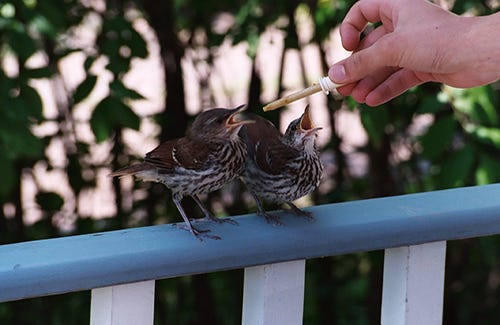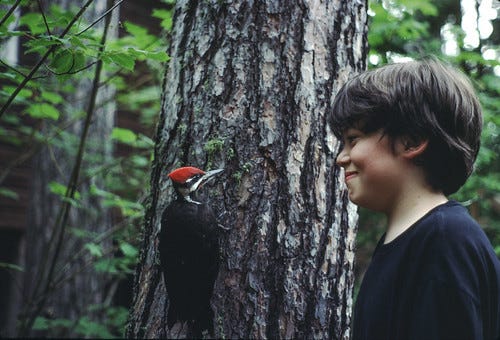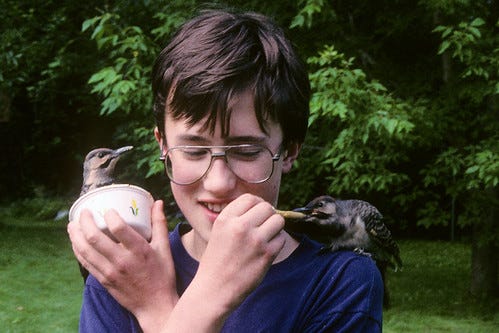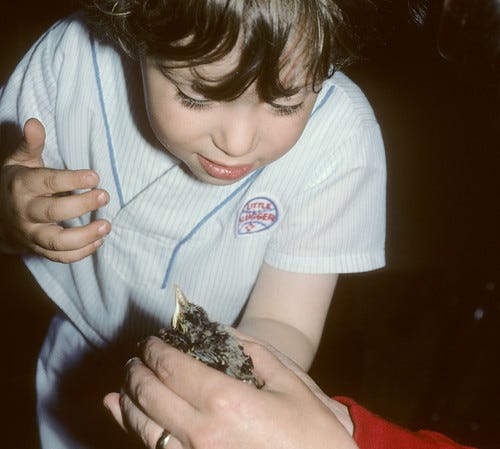(Listen to the radio version here.)
For quite a few years back in the 1980s and 90s, I was Duluth’s only licensed wildlife rehabber. Handling so many injured and orphaned birds gave me deep insights into all kinds of issues about bird biology, conservation, behavior, and intelligence. And being up close and personal with so many different kinds of birds, from loons to songbirds, gave me some of the richest, most wonderful experiences of my life.

My children enjoyed extraordinary learning experiences and developed heightened empathy for wild creatures and appreciation of nature.
How joyful were when birds we were caring for took wing and disappeared! My boys helped me feed two baby flickers one summer—the next spring, when Joey noticed a nearby flicker along his paper route and whistled, it flew right to him, landing on his shoulder!
I put five-year-old Katie in charge of a badly injured baby Pine Siskin after it recovered from its injuries until it was ready to be entirely on its own. Katie took it outside every day so it could learn about the big world, and it followed Katie indoors at the end of every day until it was ready to stay outside all the time.
It ended up spending more and more time with wild siskins and eventually left with them. But the next spring when Katie was riding her tricycle on the front sidewalk, in flew a little Pine Siskin who alighted on her finger. Just a quick visit, but how much it meant to Katie and me!
Richly rewarding as it was, rehabbing was also exhausting and too often heartbreaking. I didn’t have the kind of advanced training rehabbers must have nowadays. I was required to get injured raptors down to the Raptor Center as quickly as possible, and I sent other birds who needed more complicated care than I could provide to the Wildlife Clinic in St. Paul—for example, a loon whose bill and wings had been snagged in monofilament so badly that its entire mouth was infected. I had no way of humanely euthanizing birds and none of the confidence to be certain that a bird really was beyond recovery. A few birds that I knew were doomed actually recovered—like that Pine Siskin, who was brought to me with such severe puncture wounds from a cat attack, with damage to its respiratory system as well as other injuries, that I wouldn’t let my kids see it for a couple of weeks. But several birds in my care suffered longer than they should have because I couldn’t euthanize them.
So despite the joys, when I stopped taking birds in the late 90s, I was burned out beyond measure. I needed the break, but since then, I’ve often missed having that close connection with individual birds and the soul-deep satisfactions of releasing ones who had recovered in my care.
On Friday, for a couple of hours, I got to feel that connection with a wild bird again, but also the heartbreak. Russ was shoveling when he came upon a female Hairy Woodpecker near the street. Her wings were spread and she was breathing heavily. He got me out there within a minute. By then she’d closed her wings and tucked her head and beak into her back feathers as if sleeping. When I picked her up, she didn’t move.
It seemed clear that she had been hit by a car—she was right next to the street in a spot where she couldn’t have landed after any kind of window collision, and she didn’t appear to have any obvious wounds that could have resulted from an attack by a cat or the neighborhood Merlin.
After any kind of collision, birds often seemed dazed but then “come to,” though studies have shown that fully half of birds that seem to recover and fly off end up dying from subdural hematomas and other invisible trauma. Hope is the thing with feathers, so I placed her in a shoebox with wadded paper towels to support her, and hoped for the best.
I peeked in after about an hour, and she had perked up. I felt very hopeful when she struggled as I grasped her. So I brought her to my backyard, took a few quick photos, opened my hand, and she instantly flew straight up to a high limb of my boxelder. I was thrilled watching her take off, but when she reached the limb, she couldn’t grasp it at all and toppled to the ground beneath. Her legs were paralyzed.
Since I let my rehab license expire, I’m no longer legally allowed to treat injured birds and paralysis was beyond my skills anyway. When I was a rehabber, I discovered how vulnerable woodpeckers are to spinal injuries from collisions, and that was clearly what had happened to her. Now we have a licensed wildlife clinic here in Duluth—Wildwoods—so I brought her there. I was virtually certain that her injury was beyond repair, but I knew that her best chance of recovery was with them.
As I feared, I received this update from them:
Upon examination, staff found that the woodpecker did not have any reaction to deep pain stimuli, meaning that she had spinal trauma that was not treatable. Staff humanely euthanized the woodpecker as you suspected because of her condition. No other injuries were found, although staff suspect that she also had some head trauma and the woodpecker was on the thin side, but not emaciated.
I tried to keep this tragic outcome in perspective—at least we gave her the best care we could, and at least her suffering wasn’t prolonged. But the next morning, when I heard my male Hairy Woodpecker drumming away, I broke down crying. Two pairs of Hairy Woodpeckers spent last winter on Peabody Street, but this year there’s been just the one pair. They excavated a perfect cavity in a dead limb on that boxelder, and this poor male thought he was all settled in for the breeding season. Hairy Woodpeckers usually get all their romantic entanglements worked out in winter so they can settle in with their mate well before spring, and now he has no idea what happened. He was drumming away Sunday morning, too, but that’s the last I’ve seen or heard from him. I suspect he’s moved on in search of a new mate in time to raise a family this spring. But how I will miss both of these birds.
There’s an understandably high turnover rate for both volunteer and professional wildlife rehabbers, who must become inured to heartbreak in order to survive. I’m relieved that Duluth has Wildwoods now because I’m simply not tough enough to deal with this kind of hurt anymore.












